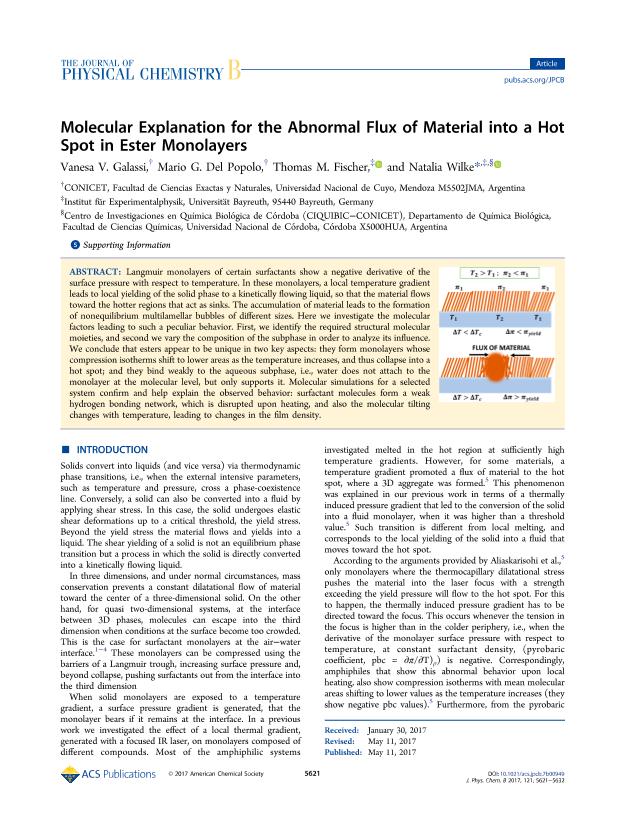Mostrar el registro sencillo del ítem
dc.contributor.author
Galassi, Vanesa Viviana

dc.contributor.author
del Popolo, Mario Gabriel

dc.contributor.author
Fischer, Thomas M.
dc.contributor.author
Wilke, Natalia

dc.date.available
2018-08-29T15:46:39Z
dc.date.issued
2017-06
dc.identifier.citation
Galassi, Vanesa Viviana; del Popolo, Mario Gabriel; Fischer, Thomas M.; Wilke, Natalia; Molecular explanation for the abnormal flux of material into a Hot Spot in Ester Monolayers; American Chemical Society; Journal of Physical Chemistry B; 121; 22; 6-2017; 5621-5632
dc.identifier.issn
1520-6106
dc.identifier.uri
http://hdl.handle.net/11336/57512
dc.description.abstract
Langmuir monolayers of certain surfactants show a negative derivative of the surface pressure with respect to temperature. In these monolayers, a local temperature gradient leads to local yielding of the solid phase to a kinetically flowing liquid, so that the material flows toward the hotter regions that act as sinks. The accumulation of material leads to the formation of nonequilibrium multilamellar bubbles of different sizes. Here we investigate the molecular factors leading to such a peculiar behavior. First, we identify the required structural molecular moieties, and second we vary the composition of the subphase in order to analyze its influence. We conclude that esters appear to be unique in two key aspects: they form monolayers whose compression isotherms shift to lower areas as the temperature increases, and thus collapse into a hot spot; and they bind weakly to the aqueous subphase, i.e., water does not attach to the monolayer at the molecular level, but only supports it. Molecular simulations for a selected system confirm and help explain the observed behavior: surfactant molecules form a weak hydrogen bonding network, which is disrupted upon heating, and also the molecular tilting changes with temperature, leading to changes in the film density.
dc.format
application/pdf
dc.language.iso
eng
dc.publisher
American Chemical Society

dc.rights
info:eu-repo/semantics/openAccess
dc.rights.uri
https://creativecommons.org/licenses/by-nc-sa/2.5/ar/
dc.subject
Negative Pyrobaric Coeficient
dc.subject
Negative Thermal Expansivity
dc.subject
Esters Thin Films
dc.subject
Abnormal Thermal Behavior
dc.subject.classification
Astronomía

dc.subject.classification
Ciencias Físicas

dc.subject.classification
CIENCIAS NATURALES Y EXACTAS

dc.title
Molecular explanation for the abnormal flux of material into a Hot Spot in Ester Monolayers
dc.type
info:eu-repo/semantics/article
dc.type
info:ar-repo/semantics/artículo
dc.type
info:eu-repo/semantics/publishedVersion
dc.date.updated
2018-08-27T18:57:23Z
dc.identifier.eissn
1520-5207
dc.journal.volume
121
dc.journal.number
22
dc.journal.pagination
5621-5632
dc.journal.pais
Estados Unidos

dc.description.fil
Fil: Galassi, Vanesa Viviana. Universidad Nacional de Cuyo. Facultad de Ciencias Exactas y Naturales; Argentina
dc.description.fil
Fil: del Popolo, Mario Gabriel. Universidad Nacional de Cuyo. Facultad de Ciencias Exactas y Naturales; Argentina
dc.description.fil
Fil: Fischer, Thomas M.. University of Bayreuth; Alemania
dc.description.fil
Fil: Wilke, Natalia. Consejo Nacional de Investigaciones Científicas y Técnicas. Centro Científico Tecnológico Conicet - Córdoba. Centro de Investigaciones en Química Biológica de Córdoba. Universidad Nacional de Córdoba. Facultad de Ciencias Químicas. Centro de Investigaciones en Química Biológica de Córdoba; Argentina
dc.journal.title
Journal of Physical Chemistry B

dc.relation.alternativeid
info:eu-repo/semantics/altIdentifier/url/http://pubs.acs.org/doi/abs/10.1021/acs.jpcb.7b00949
dc.relation.alternativeid
info:eu-repo/semantics/altIdentifier/doi/http://dx.doi.org/10.1021/acs.jpcb.7b00949
Archivos asociados
